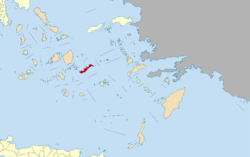Amorgos
|
Amorgos Αμοργός |
|
|---|---|

View of Chora (Amorgos)
|
|
| Coordinates: 36°50′N 25°54′E / 36.833°N 25.900°ECoordinates: 36°50′N 25°54′E / 36.833°N 25.900°E | |
| Country | Greece |
| Administrative region | South Aegean |
| Regional unit | Naxos |
| Area | |
| • Municipality | 126.35 km2 (48.78 sq mi) |
| Highest elevation | 823 m (2,700 ft) |
| Lowest elevation | 0 m (0 ft) |
| Population (2011) | |
| • Municipality | 1,973 |
| • Municipality density | 16/km2 (40/sq mi) |
| Community | |
| • Population | 414 (2011) |
| Time zone | EET (UTC+2) |
| • Summer (DST) | EEST (UTC+3) |
| Postal code | 840 08 |
| Area code(s) | 22850 |
| Vehicle registration | EM |
Amorgos (Greek: Αμοργός) is the easternmost island of the Greek Cyclades island group, and the nearest island to the neighboring Dodecanese island group. Along with several neighboring islets, the largest of which is Nikouria Island, it comprises the municipality of Amorgos, which has a land area of 126.346 square kilometres (48.782 square miles), and a population of 1,973 (2011 census).
Due to Amorgos' position opposite the ancient beaches of Ionian towns, such as Militos, Alikarnassos and Ephesos, it became one of the first places from which the Ionians passed through to the Cyclades Islands and onto the Greek mainland.
Throughout history, Amorgos was also known as Yperia, Patagy, or Platagy, Pagali, Psichia and Karkisia.
Amorgos features a lot of remnants of ancient civilizations. At the time of Archaic Greece, there were three independent city-states there. They are believed to have featured autonomous constitutions but the same currency. Amorgos is distinguished by the size and quality of the walls surrounding the city of Arkesini, by the ancient towers whose remains are scattered all over the island, by the ancient tombs, the stone tools, the inscriptions, the vases and by other antiquities.
Due to the name Minoa we suspect that Amorgos had been colonised by the Cretans from ancient times, but there are no archeological remains supporting this view.
Almost a dozen separate inhabited centres are known in this period. Amorgos is the origin of many famous Cycladic figurines. ‘Dokathismata style’ figurines were originally found here. Cycladic sculptures had been discovered from the cemeteries at Aghia Paraskevi, Aghios Pavlos, Dokathismata, Kapros, Kapsala, Nikouria and Stavros.
'Kapsala Cycladic figurines', dating around 2700 B.C., are named after a find place in Amorgos. This is the earliest of the 'canonical types' – a reclining female with folded arms. They tend to have slender and elongated proportions. At this time, anatomical features such as arms are modeled three-dimensionally. With the later types, sculptors tended to render this feature with incised lines.
...
Wikipedia


